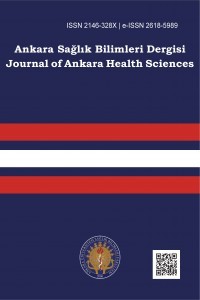SAĞLIK HARCAMALARININ GELİR ESNEKLİĞİ AÇISINDAN DEĞERLENDİRİLMESİ: SİSTEMATİK BİR DERLEME
sağlık ekonomisi, sağlık harcamaları, gelir esnekliği, OECD ülkeleri
Evaluation Of Health Expenditures In Terms Of Income Elasticity: A Systematic Review
___
- Arslan D.T. & Esatoğlu A.E. (2018). Radikal Prostatektomi Maliyetlerini ve Maliyet Etkililiğini İnceleyen Çalışmaların Sistematik Derlemesi, International Journal of Academic Value Studies, 4(18), 143-162.
- Baltagi B.H. & Moscone F. (2010). Health Care Expenditure and Income in the OECD Reconsidered: Evidence from Panel Data, Economic Modelling, 27, 804-811.
- Baltagi B.H., Lagravinese R., Moscone F. & Tosetti E. (2017), Health Care Expenditure and Income: A Global Perspective, Journal of Health Economics, 26, 863-874.
- Bilgel F. & Tran K.C. (2013), The Determinants of Canadian Provincial Health Expenditures: Evidence From a Dynamic Panel, Applied Economics, 45(2), 201-212.
- Blazquez-Fernandez C., Cantarero D. & Perez P. (2014), Disentangling the Heterogeneous Income Elasticity and Dynamics of Health Expenditure, Applied Economics, 46(16), 1839-1854.
- Braendle T. & Colombier C. (2016), What Drives Public Health Care Expenditure Growth? Evidence From Swiss Cantons, 1970–2012, Health Policy, 120, 1051-1060.
- Bustamante A.V. & Shimoga S.V. (2018), Comparing the Income Elasticity of Health Spending in Middle-Income and High-Income Countries: The Role of Financial Protection, International Journal of Health Policy and Management, 7(3), 255-263.
- Çalışkan Z. (2009), OECD Ülkelerinde Sağlık Harcamaları: Panel Veri Analizi, Erciyes Üniversitesi İktisadi ve İdari Bilimler Dergisi, 34, 117-137.
- Di Matteo L. (2003), The Income Elasticity of Health Care Spending: A Comparison of Parametric and Nonparametric Approaches, The European Journal of Health Economics, 4(1), 20-29.
- Fan V.Y. & Savedoff W.D. (2014), The Health Financing Transiton: A Conceptual Framework and Empirical Evidence, Social Science & Medicine, 105, 112-121.
- Farag M., Nandakumar A.K., Wallack S., Hodgkin D., Gaumer G. & Erbil C. (2012), The Income Elasticity of Health Care Spending in Developing and Developed Countries, International Journal of Health Care Finance and Economics, 12, 145-162.
- Lago-Penas S., Cantarero-Prieto D. & Blazquez-Fernandez C. (2013), On The Relationship Between GDP and Health Care Expenditure: A New Look, Economic Modelling, 32, 124-129.
- Liang L. & Mirelman A.J. (2014). Why Do Some Countries Spend More For Health? An Assessment of Sociopolitical Determinants and International Aid for Government Health Expenditures, Social Science & Medicine, 114, 161-168.
- Martín J., González P.L.D.A. & García M.D.C. (2011), Review of the Literature on the Determinants of Healthcare Expenditure, Applied Economics, 43(1), 19-46.
- Moher D., Liberti A., Tetzlaff J. & Altman D.G. (2009), Reprint-Preferred Reporting Items for Systematic Reviews and Meta-Analyses: The Prisma Statement, Physical Therapy, 89(9), 873-880.
- Moscone F. & Tosseti E. (2010), Health Expenditure and Income in the United States, Health Economics, 19, 1385-1403.
- Murthy V.N.R. & Okunade A.A. (2016), Determinants of U.S. Health Expenditure: Evidence from Autoregressive Distributed Lag (ARDL) Approach to Cointegration, Economic Modelling, 59, 67-73.
- Newhouse J.P. (1977), Medical-Care Expenditure: A Cross-National Survey, The Journal of Human Resources, 12(1), 115-125.
- OECD (2017), Health at a Glance 2017: OECD Indicators, OECD Publishing, Paris.
- Sülkü S.N. & Caner A. (2011), Health Care Expenditures and Gross Domestic Product: The Turkish Case, European Journal of Health Economics, 12, 29-38.
- Wang Z. (2009), The Determinants of Health Expenditures: Evidence From US State-Level Data, Applied Economics, 41(4), 429-435.
- Xu K., Saksena P. & Holly A. (2011), The Determinants of Health Expenditure: A Country-Level Panel Data Analysis, Working Paper Results for Development Institute.
- Younsi M., Chakroun M. & Nafla A. (2016), Robust Analysis of the Determinants of Healthcare Expenditure Growth: Evidence from Panel Data for Low-, Middle- and High-Income Countries, The International Journal of Health Planning and Management, 31, 580-601.
- ISSN: 2146-328X
- Yayın Aralığı: Yılda 2 Sayı
- Başlangıç: 2012
- Yayıncı: Ankara Üniversitesi
ERKEN ve ORTA ADÖLESAN DÖNEMDEKİ BİREYLERİN ANA ÖĞÜN TÜKETİM DURUMLARI ve YEME TUTUMLARI
Aylin BAYINDIR GÜMÜŞ, Hülya YARDIMCI
Emrah Gökay ÖZGÜR, Beyza DOĞANAY ERDOĞAN
Sena KAPLAN, Meryem GÜRLER, Esra ÇALIK VAR
ANNELERİN EMZİRMEYE YÖNELİK SOSYAL MEDYA KULLANIM DURUMLARI
Alev KESKİN, Zeynep Büşra TEKE
Halil İbrahim TUNA, Pınar TUNÇ TUNA, Birsel MOLU, Alev YILDIRIM KESKİN
EBELİK ÖĞRENCİLERİNİN EŞCİNSEL BİREYLERE YÖNELİK BİLGİ ve TUTUMLARININ İNCELENMESİ
A VİTAMİNİNİN NON-ALKOLİK YAĞLI KARACİĞER HASTALIĞINDAKİ ROLÜ
